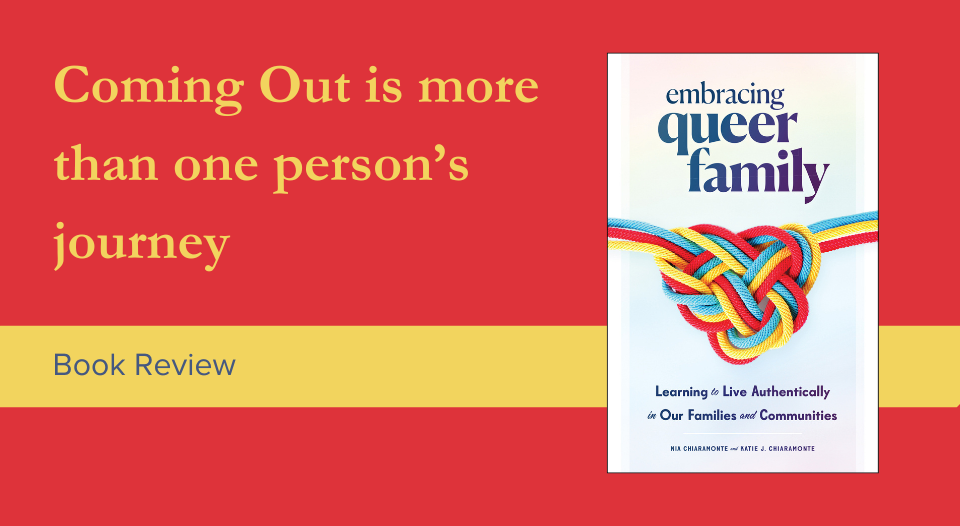Editor’s note: Embracing Queer Family uses the term “Queer” to mean “anyone who does not identify as heterosexual and cisgender.” The authors acknowledge that not everyone in the LGBTQIA+ community uses the term; the ELCA standard is “LGBTQIA+.” However, for the sake of consistency, this article uses “Queer.”
Celebrating Pride or talking about sexuality and gender can provoke strong emotions, specifically when literature is involved. Book titles lead to assumptions, prompting heated city council, where constituents demand that the subject matter be banned from local schools or libraries. In this climate the idea of another book about Queer issues can seem daunting.
Yet there are important additions to a relatively new subgenre regarding Queer identity: books about coming out. Passing on this subject and genre risks missing out on the how and why of coming out as well as the process that helps those who aren’t Queer understand what it means to be Queer and why it’s important to respect—even if you don’t accept—the situation.
Nia and Katie Chiaramonte’s Embracing Queer Family: Learning to Live Authentically in Our Families and Communities (Broadleaf Books, 2024) not only helps people as they are discovering their own identities but also helps their friends and family understand what it means to be let in during the process of coming out. This isn’t a book about what it means to be Queer, specifically, though one cannot avoid some aspects of that, but what it means to be let into that circle of trust when a person takes those first steps towards authenticity and how to navigate the revelation appropriately.
The book stresses the importance of respecting the situation even if you don’t accept it. Through each chapter, readers step through the process that is both new and familiar; discovering terminology that may be new for them, understanding what it means to struggle and come to terms one’s authentic self, facing the task of letting people in and coming out, as well as giving people a chance to be a part of your community. The process broadens out from the Queer person to the family to the community. Through it all the authors acknowledge that none of this is easy nor is every journey is the same.
A major theme of Embracing Queer Family is the “Ring Theory,” developed by psychologist Susan Silk. It establishes concentric circles of support for someone going through difficult times or life-changing events, from acquaintances to close friends to family to partners and, finally, to the self. Each ring represents an inward flow of support and an outward exhale of release. The person in the center can express their situation to each circle, but those in the circles can release their stresses only to the circles larger than their own.
According to the Ring Theory, each individual involved in a situation has their own ring of support. For the Chiaramontes, who are married, this meant that both Nia and Katie had separate rings, with many people overlapping in different ways.
“I needed people I could trust to support me [during Nia’s coming-out process],” Katie said. “Who could I bring into the circle, and who I do I need to create boundaries around?”
And while each chapter has sections where the writers open some insight into their own journey as Nia came out and transitioned, they still established hard boundaries to prevent people from being involved with their entire story. Readers are given some idea of what transpired, but the book focuses on the process of coming out—to the self, to the family and to the community—as well as how to approach and respect people who are coming out themselves. In other words, the journey isn’t the focal point, which better serves the purpose and direction.
“We wanted it to be that way, not just for Queer people but [for] people who love Queer people,” said Katie. “We didn’t want to add to the trauma of what they are experiencing. And, in order to make it an invitation to love, we have to create language, to create space for people who are not quite ready for the next step.”
The Chiaramontes come from a Protestant faith tradition but one that rejects Queer identities. Their reliance on love as the supreme ethic guiding their lives wasn’t an abstract concept but the sort of demonstrative love seen in the Gospels.
“We pored over stories of Jesus and his responses to people,” they write. “Always, Jesus responded to people in love. Those labeled prostitutes, heretics, demoniacs, and whores were accepted, loved, and empowered by Jesus. In fact, Jesus reserved his harshest criticism for those who wielded their power, both political and religious, over others to push them into lives of submission through guilt and shame.”
That can be seen in how the family left the church, and eventually the state, that they had known for years to live in a safer place and around people who embraced that kind of love.
“My idea of where God lives has grown from this experience,” Katie said.
For the Chiaramontes the expansion of who God is also brought destruction, primarily in their trust of the church. As Nia explained, they wanted people to understand that Queer people leave the church not because God has hurt them but because the people of God caused the harm.
“It’s hard for me to enter back into that community in a trusting way with the same kind of language,” she said. “I think a lot of people are wounded just like us.”
The last two chapters encapsulate the theme in an inviting way, embracing the community that’s willing to embrace the Queer person. Queer love, they said, invites people into a community that embraces them for who they are and not who others want them to be.
“It’s so hard because the church can help lead the way to give voiceless,” Nia Chiaramonte said.





